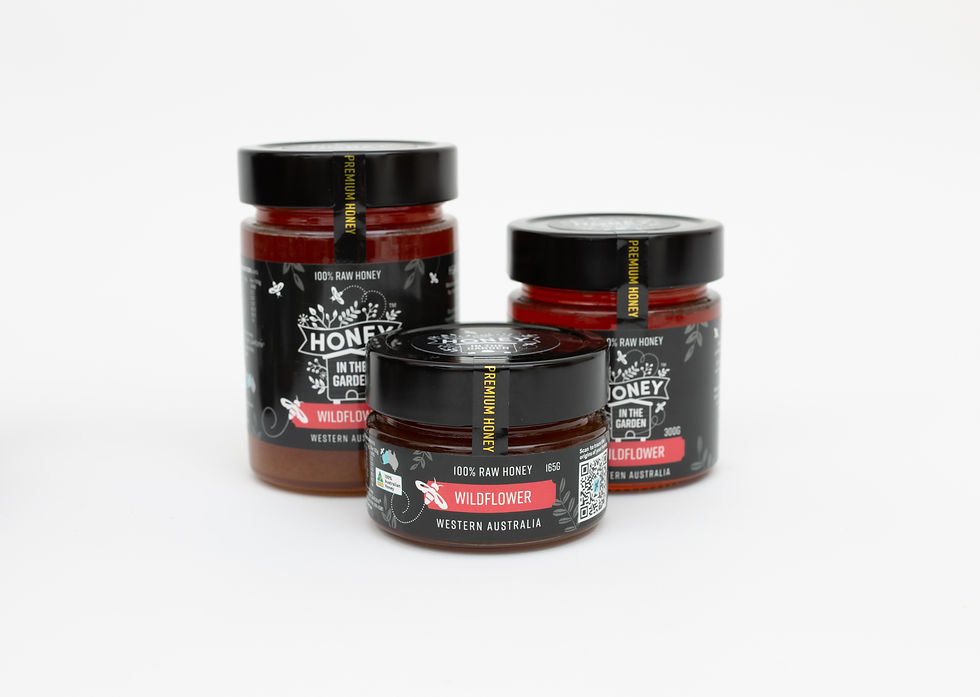Exploring the Unique Flavours of Locally Sourced Honey
- Honey in the Garden
- Jun 5
- 4 min read
Honey has captured the hearts and taste buds of many around the world. Rich in flavour and varied in texture, honey is not only a delicious sweetener but also showcases the local flora and fauna where it is produced. In this post, we will delve into the unique flavours of locally sourced honey, the art of beekeeping, the benefits of local honey, and tips for selecting the best honey for your needs.
The Wonders of Locally Sourced Honey
Locally sourced honey is unique for many reasons. Firstly, its flavour is influenced by the specific flowers from which the bees collect nectar. For example, Wandoo honey is light and mild, while Wildflower honey boasts a robust, dark flavour. The climate, season, and even the beekeeping methods can also affect the honey’s taste profile.
Moreover, local honey often contains traces of pollen from local plants. This can potentially help with local allergies as it exposes your body to small amounts of allergens over time, possibly aiding in reducing sensitivities. Many people find that consuming local honey can lead to fewer allergy symptoms, making it a natural remedy for some.

Discovering Diverse Flavours
Different regions across the globe produce honey with distinct flavours. For instance, in Australia, honey varietals can range from the light and floral Wandoo to the darker, richer Red Gum honey. Every location offers a unique blend of tastes based on the surrounding ecosystem.
The combination of these botanical sources results in an extraordinary variety of locally sourced honey, allowing consumers to experience a new flavour profile with each product. Exploring these different varieties can lead to delightful discoveries suited to individual tastes.

The Bee's Role in Flavour
The bees play a crucial role in the flavour development of honey. They gather nectar and transform it into honey through enzymes that break down sugars. The flowers that provide the nectar contribute significantly to the final taste and aroma of the honey.
Additionally, the method of extraction impacts honey’s flavour. Raw honey, in particular, retains more of the natural oils, enzymes, and pollen, producing a unique, toasty, and floral flavour. On the other hand, processed honey, which undergoes more filtration and heating, may lose some of these characteristics and taste more uniform.
For those seeking the richest flavours, look for artisanal producers who prioritize raw honey and adhere to sustainable beekeeping practices. Supporting local beekeepers ensures the continuity of unique honey flavours in the community.
Health Benefits of Local Honey
Incorporating locally sourced honey into your diet can have several health benefits. Raw honey is a natural source of antioxidants, which can combat oxidative stress in the body. Some studies suggest that honey may even have antibacterial and antifungal properties.
Moreover, local honey can also help soothe sore throats and coughs. A simple remedy involving warm water, lemon, and a spoonful of honey can provide a natural alternative to over-the-counter medications.
Additionally, honey contains small amounts of vitamins and minerals, including B vitamins, vitamin C, calcium, and iron. These nutrients contribute to overall well-being, making honey a delicious and healthy additive to your meals.

Selecting the Best Honey
When selecting honey, there are several factors to consider to ensure you get the best quality. Here are some practical tips:
Look for local labels: Choose honey that has been sourced locally. This supports local beekeepers and ensures fresher products.
Check for raw honey: Choose raw, unfiltered honey for the most nutrients and minerals. Raw honey retains its natural flavours and medicinal properties.
Observe the colour and consistency: High-quality honey should have a distinct colour that reflects its floral source. It should also be thick and viscous, indicating good quality.
Explore different varieties: Don’t stick to one type of honey. Experiment with Wildflower, Marri, Jarrah, Blackbutt, Wandoo, and other varieties to discover new tastes.
By exploring these options and learning about the distinct characteristics of local honeys, you can enhance your culinary experiences and health.
Experiencing Honey Tasting Events
Participating in honey tasting events is an exciting way to explore the unique flavours of locally sourced honey. Many local farms and beekeeping associations host tasting sessions where you can sample various honey types and learn about the production process.
These events often feature direct interaction with beekeepers, providing insights into their methods, the conditions under which the honey is produced, and the best uses for each type. Some workshops even include food pairings, helping you understand which honeys complement different cuisines.
In areas like Bayswater, supporting local initiatives like honey in the garden bayswater can lead to discovering exquisite varietals not commonly found in stores.
A Sweet Conclusion
Locally sourced honey opens up a world of flavours and health benefits. By understanding the nuances of different honey varieties and supporting local beekeepers, you not only enjoy unique tastes but also contribute to sustainable agriculture. The next time you reach for honey, consider exploring local options to support your community and enjoy the rich flavours that Nature's tiny artisans create. Happy tasting!







Comments